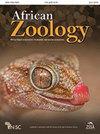A Malagasy Element in Continental Africa: A New Subspecies of the Rare Amauris nossima (Nymphalidae, Danainae) from the Kenyan Coast
IF 0.5
4区 生物学
Q4 ZOOLOGY
引用次数: 2
Abstract
Amauris nossima Ward (Nymphalidae, Danainae) was known before this study only from Madagascar and the island of Mayotte, without clearly defined subspecies, but with five names considered invalid or infrasubspecific. It has generally been considered a rare species of butterfly classified by IUCN as vulnerable (Vu B1 + 2c). Here, it is reported for the first time from continental Africa. A new subspecies A. nossima mrima n. ssp. is described from two remnants of rain forest, Mrima and Buda, on the southern Kenyan coast, where it occurs sympatrically with Amauris ochlea Boisduval, widely distributed in East Africa. Their, previously predicted, sister-species status is confirmed by morphological (male and female genitalia) and partial mitochondrial (COI) data. The finding of A. nossima in Kenya opens the discussion on a possible recolonization of Africa from Madagascar, which would be an exception to a predominant biogeographical pattern of African origin of Malagasy butterflies via overseas dispersal.非洲大陆的一种马达加斯加元素:肯尼亚海岸稀有的Amauris nossima(睡蝶科,Danainae)的一个新亚种
Amauris nossima Ward(睡蝶科,Danainae)在本研究之前仅在马达加斯加和马约特岛已知,没有明确定义的亚种,但有五个名称被认为无效或亚特异性。它通常被认为是一种罕见的蝴蝶,被国际自然保护联盟列为易危物种(Vu B1+2c)。这是非洲大陆首次报道。一个新亚种A.nossima mrima n.ssp。描述自肯尼亚南部海岸的两个雨林遗迹Mrima和Buda,在那里它与广泛分布在东非的Amauris ochlea Boisduval共病。形态学(雄性和雌性生殖器)和部分线粒体(COI)数据证实了它们之前预测的姐妹物种状态。A.nossima在肯尼亚的发现开启了关于非洲可能从马达加斯加重新殖民的讨论,这将是马达加斯加蝴蝶通过海外传播的非洲起源的主要生物地理模式的例外。
本文章由计算机程序翻译,如有差异,请以英文原文为准。
求助全文
约1分钟内获得全文
求助全文
来源期刊

African Zoology
生物-动物学
CiteScore
2.60
自引率
9.10%
发文量
18
审稿时长
>12 weeks
期刊介绍:
African Zoology , a peer-reviewed research journal, publishes original scientific contributions and critical reviews that focus principally on African fauna in terrestrial, freshwater, and marine ecosystems. Research from other regions that advances practical and theoretical aspects of zoology will be considered. Rigorous question-driven research in all aspects of zoology will take precedence over descriptive research. The Journal publishes full-length papers, critical reviews, short communications, letters to the editors as well as book reviews. Contributions based on purely observational, descriptive or anecdotal data will not be considered.
The Journal is produced by NISC in association with the Zoological Society of South Africa (ZSSA). Acceptance of papers is the responsibility of the Editors-in-Chief in consultation with the Editors and members of the Editorial Advisory Board. All views expressed are those of the author and not necessarily those of the Editors or the Department.
 求助内容:
求助内容: 应助结果提醒方式:
应助结果提醒方式:


